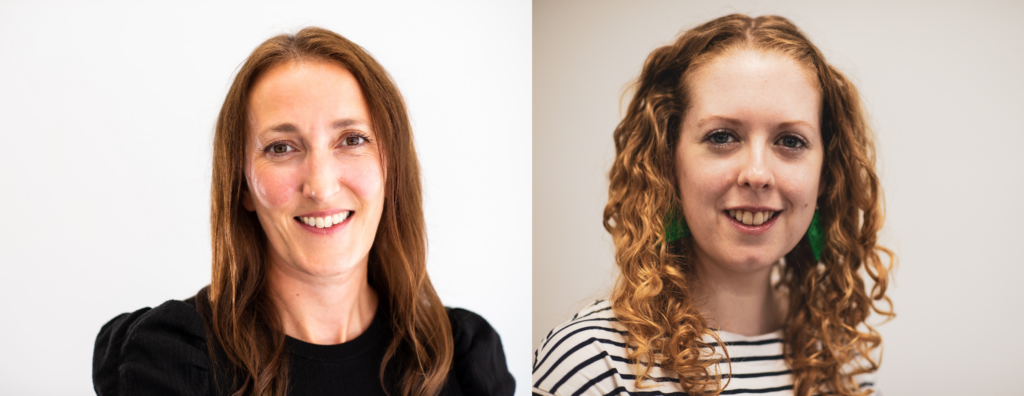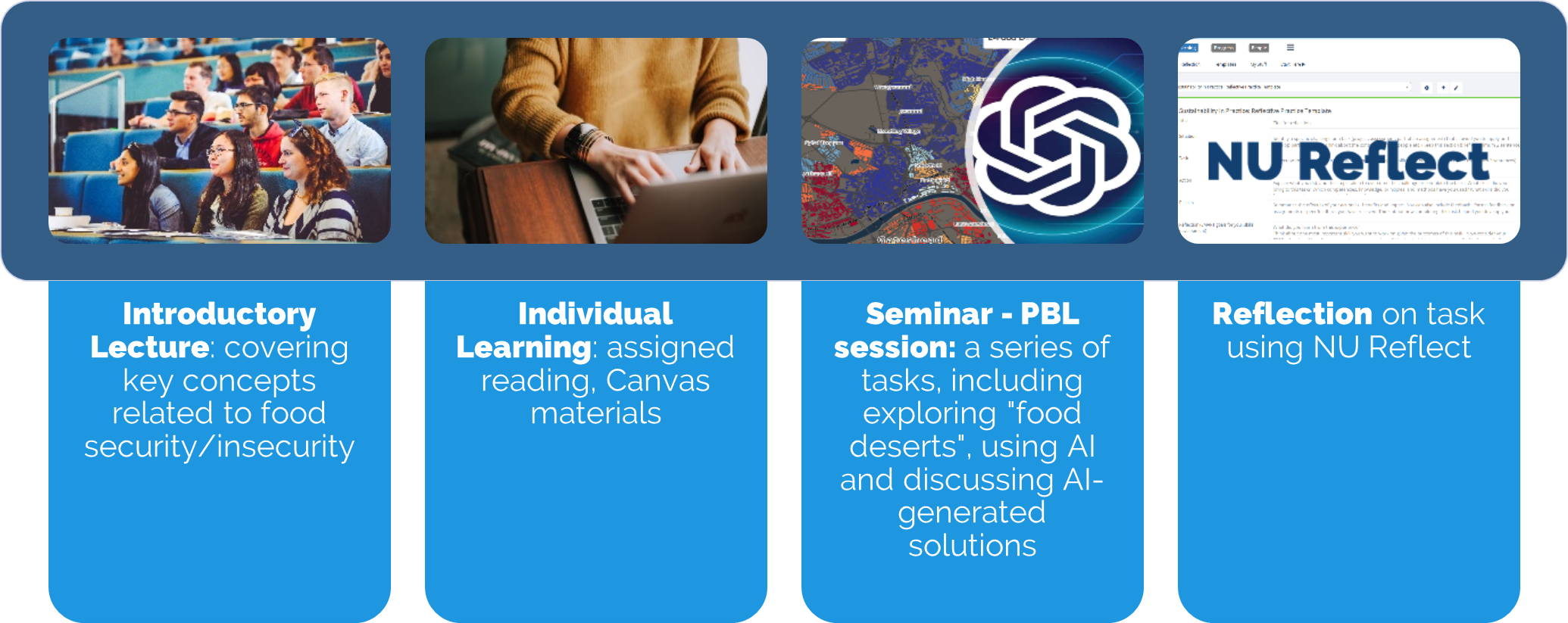Dr Amy Proctor, Dr Beth Clark
School of Natural and Environmental Science (SNES)
Faculty of Science, Agriculture & Engineering (SAgE)

What did you do?
We designed a problem-based learning session for students of Sustainability in Practice – a shared module for Agriculture, Earth and Environment, and Applied Social Sciences Cluster (AESSC) students in SNES, starting in September 2023/24. In this session, we are planning for students to use AI tools to generate solutions to food insecurity, and evaluate them critically.
Who is involved?
Dr Amy Proctor, module leader of Sustainability in Practice; Dr Beth Clark; with support from Learning and Teaching Development Service advisers, Michelle Black and Gosia Rabenda Derman.
How did you do it?
In designing the problem-based learning (PBL) session for the Sustainability in Practice module, we took several steps to ensure an engaging and interactive learning experience for the students. Here’s an overview of the sessions for students:
Introductory Lecture: The session will begin with an in-person introductory lecture, covering key concepts related to food security/insecurity. The lecture will cover topics such as global hunger, food security pillars, measurement of food insecurity, and the effects of food insecurity in a UK context.
Seminar and Individual Learning: Following the introductory lecture, students will participate in a two-hour seminar. Prior to the seminar, students will be assigned assigned a short reading related to food security. During the seminar, students will have the opportunity to ask questions and seek clarification on the reading material.
Problem-Based Tasks: The core of the PBL session involves a series of tasks centred around the issue of food deserts and food insecurity in Newcastle. These tasks will encourage students to apply their knowledge, use AI tools, and think critically about potential solutions:
- After exploring local “food desert” maps, students will be asked to identify potential factors contributing to food insecurity and categorise these factors under the four pillars of food security (availability, accessibility, utilisation, and stability) based on the lecture content and additional readings.
- Next, students will use AI tool of their choice (e.g., ChatGPT, Bard) to generate three different strategies to address food insecurity in Newcastle upon Tyne, and critically evaluate them. This task aims to foster problem-solving, and an understanding of how AI can be utilised for real-world challenges. Students will be asked to critique the solutions generated by the AI, so rather than just use rely on technology, they will develop their critical thinking skills.
- Finally, students will be asked to log into NuReflect, use the STARR/SMART template to reflect on their learning experience. They will input skill and/or knowledge development they acquired throughout the PBL session.

Why did you do it?
The Sustainability in Practice module adopts a problem-based learning (PBL) approach, which has numerous benefits to students. First of all, the PBL promotes active learning by placing students in the centre of the learning process. Instead of passively receiving information, students engage in hands-on activities, collaborate with peers, and think critically about real-world problems.
The PBL session bridges concepts from multiple disciplines, and students will work in multidisciplinary groups. This approach encourages students to make connections between different areas of knowledge, fostering a holistic understanding of complex problems.
Addressing food insecurity and utilising AI tools are highly relevant contemporary challenges. By incorporating these themes into the PBL session, students will gain practical skills and knowledge that can be applied beyond the classroom. They will develop a better understanding of sustainability challenges and the potential of AI in addressing them. At the same time, developing their critical thinking skills, they will notice that the AI-generated solutions might not be accurate and relevant to the local context, so own research and creativity are crucial in addressing any sustainability challenge.
Through the tasks, students are encouraged to think critically, analyse data, use technology (AI tools, but also digital mapping), and evaluate different perspectives. They develop problem-solving skills, as well as the ability to approach challenges with creativity and innovation.
Does it work?
The session will be run in the next academic year, however we have tested it in a focus group, which highlighted how we can improve the scenario and what challenges it presents.
Some participants appreciated the inclusion of AI tools, stressing that utilising AI is an important digital competency:
I liked how task 3 (…) mentions use of AI, and I think that’s really good. Moving forward, that should definitely be included because people are going to use it anyway. I think it’s good to encourage the use of it, the idea is obviously not to do your actual work, but just to generate ideas.
The focus group results, however, also highlighted some challenges of introducing AI to students. Participants noted that the AI-generated solutions lack originality and may lead to repetition in group discussions. Participants also stressed that students will need more guidance on ethical use of AI, and supporting other skills alongside utilising AI: such as conducting own research, developing independence, or referencing.
Lots of people don’t even really know what it is [AI], even though it’s all in the media. So maybe add ways that you could efficiently use that to supplement your learning.
When observing students participating in a focus group, we also noticed that it is crucial to focus on developing critical thinking skills – so students are equipped in skills to use AI to enhance their learning, rather than rely on generating chat answers. This was also noted in the feedback from students – they recognised that the Chat GPT-generated answers are only a starting point to further research.
We thought, the strategies [generated by AI] are good and they’re quite realistic. And they’re definitely a good starting point to undergo further research. AI doesn’t tell you where the information comes from. So we thought that was a good starting point, but obviously there’s more detail needed.
Top tips on using AI with students
Based on testing the scenario with students during a focus group, we can offer some considerations when it comes to using AI with students:
- Use the AI in an active learning context and for authentic tasks: for example PBL sessions which actively engage students in hands-on activities and collaborative problem-solving.
- Utilise AI tools for problem-solving, and not knowledge-retention style quizzes. Task students with using AI tools to generate potential solutions and critically evaluate them. This exercise helps students understand the capabilities and limitations of AI while developing their own critical thinking abilities.
- Emphasise the importance of research and creativity. Encourage students to conduct their own research, think creatively, and consider multiple perspectives. While AI-generated solutions can provide valuable starting points, students should recognise the need for independent thinking and exploration to develop innovative and contextually relevant solutions.
- Offer guidance on the ethical use of AI tools, ensuring students understand the potential biases and limitations of AI-generated content.
The Graduate Framework
The project demonstrated the following attributes:
- Collaborative
- Creative, innovative and enterprising
- Critical Thinker
- Curious
- Digitally capable
- Engaged
- Future-focused
- Globally and culturally aware
- Reflective and self-aware
- Socially responsible
Want to know more?
You can contact Dr Amy Proctor to learn more.
Resources on AI:
- AI in Practice (live document maintained by LTDS/FMS-TEL)
- Artificial Intelligence (AI) | Learning and Teaching @ Newcastle | Newcastle University (ncl.ac.uk)
- Students can be signposted to AI and Academic Integrity materials on Academic Skills Kit website.
- This year’s Art of the Possible featured talks and workshops on using AI in education. You can catch up with recordings and presentations on LTDS blog.
You can read more about the AESSC programme development and module design project on Learning & Teaching website.
